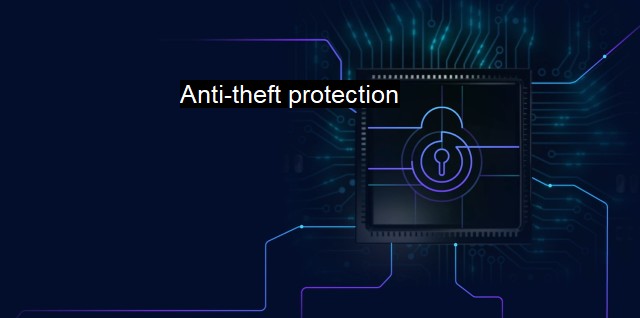What is Anti-theft protection?
Securing Data in the Digital World: Defining the Importance of Anti-Theft Protection in Cybersecurity and Antivirus Solutions
Anti-theft protection in the context of cybersecurity and antivirus refers to a wide range of security measures and strategies designed to prevent unauthorized access, use, alteration, or theft of data and digital assets. These systems function by preventing, identifying, and reacting to any attempts at unauthorized activity, thereby defending the privacy, integrity, and value of digital assets.Cybersecurity designates the practices and technologies developed to protect computers, servers, mobile devices, electronic systems, networks, and data from online theft or damage. While antivirus is a type of software primarily designed to detect, prevent, and remove malicious software, specifically viruses, from our devices.
Anti-theft protection represents a broader protective umbrella with taking the notion of safety beyond just antivirus shields, encompassing strategies against fraudulent transactions on online platforms, identity theft, phishing attempts, and recognize theft of confidential business information.
A prominent part of anti-theft protection lies in preventing unauthorized access. Strategies can involve two-factor authentication, where a user needs an extra confirmation of originality beyond the norm of username and password. This might be a singular code sent to the user's phone or email address. Cryptography is another significant method used in a similar fashion, where data being sent over a network is encrypted, meaning it's turned into a code that can only be unraveled with the correct decryption key.
Similarly, password security is part of the protective measures. Passwords employ a series of alphanumeric characters functioning as user access/assertion keys. Strong and properly managed passwords help protect our personal or business information. Software that can monitor and detect brute force attempts, where hackers make continuous password guesses in short timespans, are imperative.
Anti-theft protection in IT security systems plays a significant role in preventing unauthorized device usage, even if the device somehow falls into the wrong hands. Remote tracking strategies are widely used in this context, as an outside server can track lost/stolen equipment. If needed, built-in functionalities in modern devices allow data wiping, essentially erasing all data on a device from afar.
(contd.)
Email security is another cornerstone within the scope of anti-theft protection. Security measures such as encryption are enforced to make the contents of emails inaccessible to individuals other than the intended recipients. Firewalls can protect the network as the gatekeepers by monitoring incoming and outgoing traffic against a specified set of security rules.
Anti-malware software that constantly watches over the internet activities, behavioral-based detection systems that track normal operational schedules to point out anomalies, patch management ensuring constant updates against emerging threats, assembling these can create a diversified protective wall of anti-theft protections.
Safe web practices are also crucial, as harmful influences often find a way into systems through human error. Users are educated about safely browsing the web, spotting a phishing email, avoiding dubious websites, or about being wary of potential internet scams aiming at stealing financial data to keep safety practices up to date.
In terms of protecting eCommerce or money-related digital transactions, Safe Payment processes are vital elements. Systems are often designed to anonymize card data, are crypto-secure, or use escrow services until the transaction has been conclusively validated.
Anti-theft protection isn’t just about preventing attacks, but also carrying out damage control when one occurs. Incident response strategies are developed to ensure swift and decisive actions are made to limit harmful results, duration, and costs when a security breach or incident does take place.
In business contexts, digital asset loss translates into monetary and reputational damage. In the context of an individual end-user, this can mean the loss of significant personal data or potentially, access to their financial assets. Anti-theft protection is an integral part of cybersecurity, employing a multi-layered security approach to protect online users and businesses from cyber threats. It is the preventive aspiration at work, the constant endeavour to stay ahead of criminals lurking in the digital space.

Anti-theft protection FAQs
What is anti-theft protection in the context of cybersecurity and antivirus?
Anti-theft protection refers to a set of security features that can prevent unauthorized access to your device if it is lost or stolen. This can include remote locking, location tracking, and data wiping capabilities.Why is anti-theft protection important for cybersecurity?
Anti-theft protection is important for cybersecurity because it can help prevent unauthorized access to sensitive data in the event that your device is lost or stolen. It can also potentially locate the device, making it easier for law enforcement to recover it.What kind of devices can benefit from anti-theft protection?
Any device that connects to the internet and stores valuable data can benefit from anti-theft protection. This includes laptops, smartphones, tablets, and other mobile devices.What are some examples of anti-theft protection features?
Some common anti-theft protection features include remote lock and erase capabilities, location tracking, and biometric authentication. Some antivirus software also includes anti-theft protection features such as device monitoring and remote alarms.| | A | | | B | | | C | | | D | | | E | | | F | | | G | | | H | | | I | | | J | | | K | | | L | | | M | |
| | N | | | O | | | P | | | Q | | | R | | | S | | | T | | | U | | | V | | | W | | | X | | | Y | | | Z | |
| | 1 | | | 2 | | | 3 | | | 4 | | | 7 | | | 8 | | |||||||